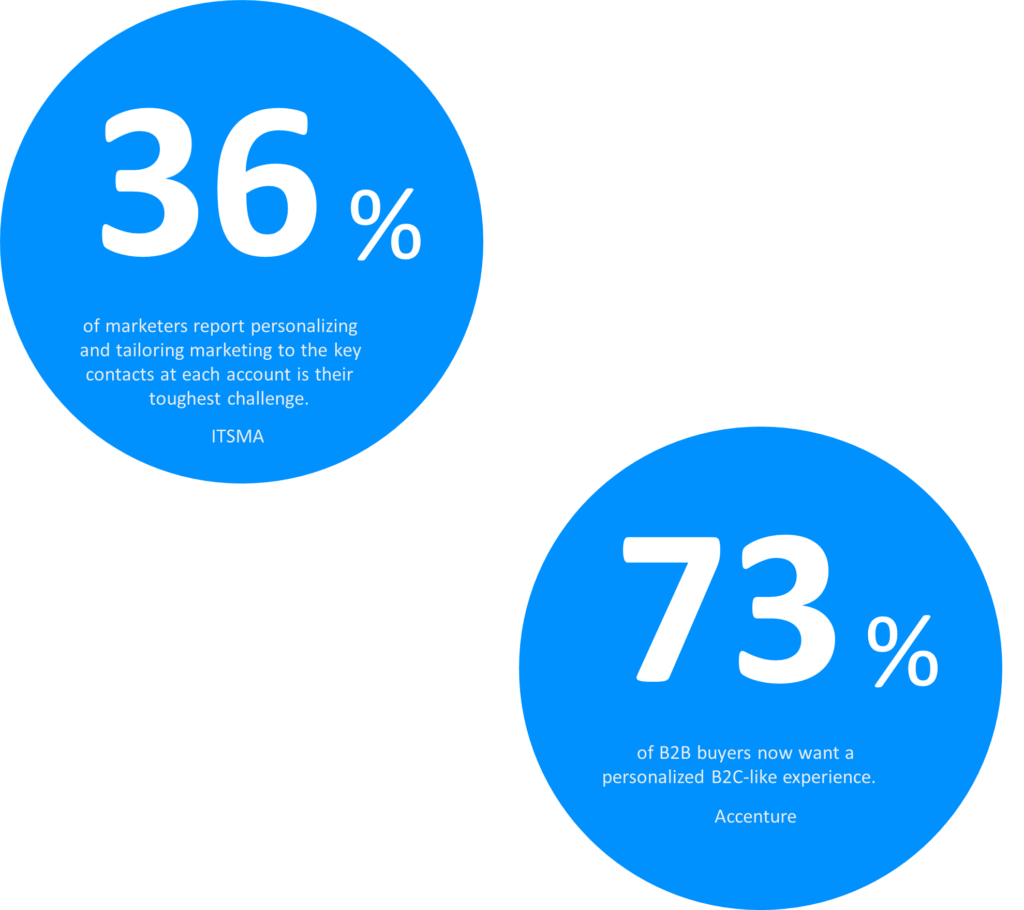Getting full value from content syndication
Content syndication is a classic tactic in B2B marketing. However, if you are just using content syndication to generate leads without aligning it to your ABM strategy, you are leaving money on the table.
Let’s address some misconceptions. Many B2B marketers are leery of content syndication due to the perception that the leads it generates are not “fully qualified.” This is fair. A buyer who reads a single piece of content from syndication does not make them a fully qualified lead. But this is true for any buyer interacting with a single tactic. Marketers should not send these leads directly to sales unless they have reached a qualification threshold.
However, if you omit content syndication from your marketing mix, you are missing out on early buying signals. This is a crucial point, given how B2B buying behavior has changed:
- Purchases are increasingly made by buying groups, rather than individuals.
- Buyers are doing significant research for purchases online on third-party websites.
- Buyers frequently make their purchase decisions before speaking with sales.
In light of these changes, the approach to content syndication needs to change too. To fully use content syndication in today’s environment, stop using it as a one-off demand tactic and instead incorporate it into your ABM programs to:
- Extend the reach of ABM content.
- Respond to purchase intent signals.
- Leverage for database growth.
- Identify active buying groups within accounts.
This guide will examine each of these use cases for content syndication.
B2B marketing functions spend between 5–11% of their demand program budget on content syndication
Forrester Tracking the True Costs of Marketing 2021
Extend the reach of ABM content
Effective ABM programs rely on content that has been customized for large-, named-, or vertical/segment-based clusters of target accounts. Content customization can include specific personas, topics, messaging, value propositions, terminology, and localization. This is expensive and resource-intensive content to produce, and you should use it in every possible effective channel. Using content syndication as part of the ABM program improves both content reach and ROI.
How to do this:
- First, you must ensure that target account segmentation is done in a manner that supports effective messaging. Many marketing teams segment accounts based on sales territories, which does not allow you to message to groups of similar accounts. Instead consider factors such as account size or maturity, industry, existing customer relationship, etc.
- Next, you need to develop relevant content for each audience segmentation. Sometimes this means repurposing existing content; other times new content is required.
- Then, you need to find the right media partners to support your ABM syndication efforts. Key criteria to look for include the media partner’s ability to target at the account level (vs. individual buyers), and access to the publications that resonate with buyers in your target accounts.
- Finally, you can start the syndication of content to your target account buyers..
What you gain:
- Using content syndication in this way will allow you a low-cost way to test your account segmentation strategy and messaging.
- You can determine what content resonates with buying groups at your target accounts, see the specific topics account buyers are interested in, and surface any early buying signals at an account level.

Respond to purchase intent signals
Intent data is an increasingly critical resource for B2B marketers. Intent data is the collection of first-, second-, and third-party behavioral signals that help interpret B2B purchase intent.
Once buyers within target accounts are displaying purchase intent signals (e.g., multiple contacts within an account are researching specific terms, “bingeing” on certain content, responding to marketing offers, etc.), specific ABM content syndication outreach can be set up to respond.
How to do this:
- First, you must again ensure that target account segmentation is done in a manner that supports effective messaging and content development. This is a core best practice for ABM marketing.
- Next, you need to compare your existing ABM content with your intent data findings and address any gaps to share content that supports the research the buying groups are doing. This is done by either modifying existing content to align to topics of interest or creating new content.
- Start syndication of the relevant content to target account buyers displaying purchase intent.
What you gain
- You quickly activate your first-, second-, and third-party intent data (that you have likely paid a significant amount for) to accelerate account opportunities.
- You prove to buyers that you’re a valuable and responsive vendor by giving them content on the topics they are currently researching and interested in.

Fill buying group gaps in your database
Given that B2B purchasing is now a team activity — with an average of 12–18 buyers involved in a purchase decision — it’s vital for B2B marketing and sales teams to identify the buying groups at target accounts — and not just the contact information for buying group members. It’s critical to know the roles individuals play in the purchase cycle such as the champion, the decision maker, and influencers.
Lack of buying group visibility is a big issue at B2B companies, with many sales reps only speaking with a single contact at each target account. Content syndication can fill database gaps and build out the buying group picture.
How to do this:
- Start by partnering with your marketing operations team to determine database buying group gaps in target accounts.
- Then, compare this information with marketing contact/lead data for target accounts.
- Next, develop relevant content for target account buyers, based on your account segmentation strategy.
- Finally, syndicate relevant content to target account buyers and use the data you collect to build out a more complete picture of buying group members at your target accounts.
What you gain:
- You locate additional members of account buying groups (at a low cost) who could be deal champions, influencers, or users and make them visible to sales.
- You ensure that sales reps are talking to multiple people at an account and building deeper account relationships.
- With the full buying group identified, you’re able to open the door to cross-sell/ upsell opportunities and better track marketing influence at the account level.
6x
increase in lead-to-pipeline conversion when B2B marketing teams leverage account intelligence to prioritize buyers and buying groups.
Bombora
Identify active buying groups for sales
With B2B purchases now being driven by buying groups, rather than individuals, marketing needs to transition from “leads” to buyer group-based opportunities. Marketing needs to stop handing off individual leads (especially poorly qualified ones) to sales.
Instead, effective B2B marketers should score and share insights on buying group activity within target accounts with reps. Leveraging content syndication allows you to identify early buying signals — and conversation starting topics — within accounts.
How to do this:
- First, work with your marketing operations team to build and implement an account scoring model (in your CRM or marketing automation platform) that increases the score of an account as more members of the buying group engage.
- Next, implement a field on the CRM contact record that shows the syndicated content that individual buyer group members have engaged with. This gives reps greater context into the specific topics that the buying group is interested in.
- Finally, enable sales on these changes so that reps can identify and prioritize engagement with accounts with high buying group scores..
What you gain:
- You get better qualified opportunities. Instead of having sales follow-up with poorly qualified individual leads, reps can now focus on accounts showing active buying signals based on the level of buying group engagement.
- The company gains better sales productivity. Sales reps save time on opportunity identification, have greater precision in their follow-up with accounts, and can provide a better buying experience.
94%
of purchasing decisions are made by buying groups.
Forrester
“It’s important to ensure your content syndication channels are fully integrated with your ABM program. Content syndication feeds ABM. If you have contacts that have a high-heat index and are repeatedly downloading your content from numerous sources, it really signifies intent, and gives you the ability to add another group to your ABM program.”
Pamela Guyton-Micheles
Senior Manager of Demand Generation Marketing | Avalara

